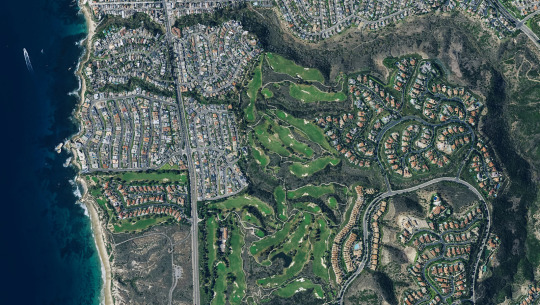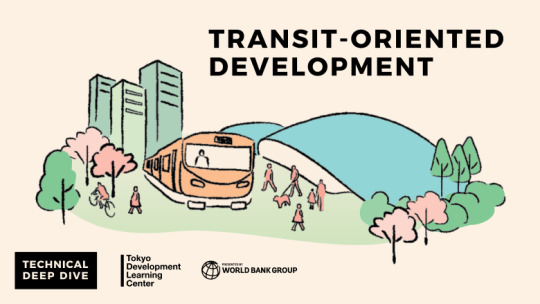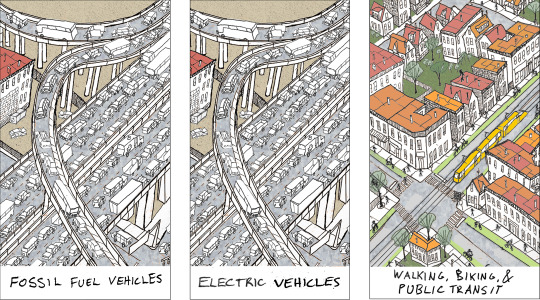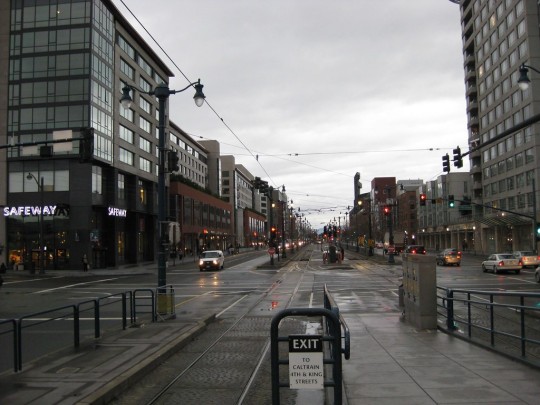#Transit-Oriented Development
Explore tagged Tumblr posts
Text
Redeveloping park-and-ride lots is a common step in mass transit planning; consensus view is that parking lot land is better used for development that can make use of the transit service on its doorstep! Maybe even better if the parking is going unused/is underutilized... (but that suggests other issues, like the transit system is not popular.) Key will be a concept that encourages less auto ownership if it's residential. Otherwise the parking can overload the adjacent neighbourhoods.
0 notes
Text
URBAN SPRAWL

Urban Sprawl is the uncontrolled expansion of urban areas into surrounding rural or natural areas. It's leading to low-density development, increased car dependence, and environmental consequences such as habitat loss and air pollution. It often results in inefficient land use, strain on infrastructure, and social issues like increased commuting times and the decline of central city areas. Understanding urban sprawl involves considering its impact on transportation, environment, and community development, which can inform strategies for more sustainable urban planning and growth management.
This phenomenon is often characterized by low-density development, reliance on automobiles for transportation, and the fragmentation of natural habitats. Urban sprawl can lead to a variety of negative consequences, including increased traffic congestion, air and water pollution, loss of agricultural land, and decreased quality of life for residents.
Transit-Oriented Development (TOD) is a concept that has gained significant traction in urban planning and design in recent years. It is a multifaceted approach to urban development that centers around creating vibrant, livable, and sustainable communities with a strong emphasis on public transportation and walkability.
At its core, TOD seeks to create compact, mixed-use, and pedestrian-friendly neighborhoods that are centered around high-quality public transportation systems, such as buses, subways, light rail, or commuter rail. The aim is to reduce reliance on private automobiles and promote more sustainable modes of transportation, thereby mitigating traffic congestion, reducing air pollution, and fostering a more connected and environmentally friendly urban environment.
Key principles of Transit-Oriented Development include:
Proximity to Transit: TOD emphasizes the development of residential, commercial, and recreational spaces within close proximity to transit stations or stops, typically within a half-mile radius. This encourages residents and workers to use public transportation for their daily commutes and errands.
Mixed-Use Development: TOD promotes a mix of land uses, including residential, commercial, retail, and recreational spaces within the same neighborhood. This diversity of land uses encourages a vibrant and dynamic urban environment, reduces the need for long commutes, and fosters a sense of community.
Pedestrian-Friendly Design: TOD places a strong emphasis on creating walkable neighborhoods with well-designed sidewalks, pedestrian pathways, and public spaces. This encourages active transportation, enhances the overall quality of life, and promotes social interaction.
High-Density, Compact Development: TOD often involves higher-density development, including mid-rise and high-rise buildings, to maximize land use efficiency and support a critical mass of residents and workers near transit nodes.
Sustainable Design and Environmental Considerations: TOD prioritizes sustainable design practices, such as energy-efficient buildings, green spaces, and stormwater management, to minimize environmental impact and promote resilience.
Overall, Transit-Oriented Development represents a holistic approach to urban planning and design, aiming to create vibrant, accessible, and sustainable communities that are well-integrated with public transportation infrastructure. By fostering a seamless connection between land use and transportation, TOD has the potential to reduce car dependency, enhance mobility, and create more livable urban environments.
Sonetra KETH (កេត សុនេត្រា) Architectural Manager/Project Manager/BIM Director RMIT University Vietnam + Institute of Technology of Cambodia
#TOD#Sonetra Keth#NETRA#នេត្រា#Urban Sprawl#Urbanism#Urban Design Principle#Architectural Manager#Project Manager#Real Estate Developer#Transit-Oriented Development#<meta name=“google-adsense-account” content=“ca-pub-9430617320114361”>#crossorigin=“anonymous”></script>#<script async src=“https://pagead2.googlesyndication.com/pagead/js/adsbygoogle.js?client=ca-pub-9430617320114361”#<meta name=“monetag” content=“07e99e76c61091cfc8c3590b90f57e37”>
0 notes
Text
Housing is a queer issue
what's the number one reason someone has to stay somewhere unsafe? Can't afford to live somewhere else.
Queer folks are more likely to experience homelessness, trans folks even more so. And that's likely to set off a cascade of consequences with issues getting a job, accessing health care, and so on.
Wherever you live, show up for Planning & Zoning meetings or write a letter when they're considering higher density housing and especially if they're considering zone changes like Transit Oriented Development (TOD). Those aren't just for big cities!
Show up and say "Yes, I want Those People to live HERE".
Yes, In My Back Yard.
Say yes to infill especially where existing in-town lots with access to services are rezoned to higher density units. The new apartments should go where the sewer line already is, not where it requires running a whole new spur and where everyone is isolated and requires a car to get everywhere.
Say yes to that public housing in the downtown core where people can WALK to all the services they need.
Everyone should have access to safe affordable housing. You won't know who exactly you're helping, but you're helping tear down a barrier for everyone.
26 notes
·
View notes
Text

This sludgy, slippery sidewalk on Grant Street is the only pedestrian route between King Memorial Station & the apartments completed a couple of years ago as a "transit-oriented development."
Ownership is split among MARTA, Atlanta & CSX. We need those parties to cooperate.
My understanding is that the water comes from the portion that CSX owns (the ground behind the wall, which lies under their freight rail line), it seeps through the tunnel wall that MARTA owns, and lands on the sidewalk the City owns. All three entities will need to cooperate to fix it.
I'm not convinced we can truly call this a transit-oriented development until it becomes a great space for pedestrians.
14 notes
·
View notes
Text
Our urbanism is not controlled entirely by developers & lenders

This eyesore sits across the street from Lenox MARTA Station and PATH 400, wasting space that could hold transit adjacent development.
This was a Houston's restaurant until about five or six years ago when it closed.
Unfortunately the only thing that's been proposed for the property is a luxury apartment tower perched atop a parking deck with 458 spaces. (FYI, zero parking is required for this spot because of its proximity to a MARTA station.)
Am I being too picky in expecting the city to find a way to add affordable homes, with a progressively-low amount of parking, near MARTA stations? Even in Buckhead?
Many will say I'm being too picky, and that my ask is unrealistic given the market forces at play. Yes, it's true that if you let the market do whatever it wants, lenders and developers will primarily create luxury apartments with massive parking decks near transit stations in the hotspot neighborhoods.
That's the conservative choice that they will make, based on assumptions that Atlanta is immovably a car-oriented city.
But our urbanism is not entirely at the mercy of lenders and developers. *Anyone who tells you otherwise likely has selfish motives*. (Seriously, look suspiciously at anyone who says we have to just let developers and lenders do what they want, and that we can't influence what they produce.)
We've bent over backwards for all kinds of corporate relocations and sports events. We've reshaped the city in many ways that were harmful or questionable, using public financing tools to make it work. Let's bend over backwards for better urbanism now.
Instead of just being a city that defines success largely by its ability to attract major sports events and corporate headquarters, we can be a city that triumphantly overcomes the damage of car-centric sprawl and development inequity.
We can do it by rebuilding our urban fabric for pedestrian-oriented, affordable density -- and making excellent use of the land near our precious rail investments.
It's not just a "nice to have" dream. I think it's something we need to have, and that we need to all expect from our growth.
#atlanta#urbanism#marta#urban development#urban planning#transit oriented development#affordable housing
28 notes
·
View notes
Text
Great Idea 19: Transit-oriented development

Transit-oriented development links transportation and land use—providing people with maximum choice in how to get around by intensifying activities near transit nodes with high quality public space. Read more.
#great ideas#new urbanism#urban design#urbanism#cities#walkability#transit#transit oriented development#development#TOD
12 notes
·
View notes
Text
2 notes
·
View notes
Text
last week of legislative session is stressing me the fuck out...can we get some land use reform? can we PLEASE get some land use reform?? just a crumb????????
#and of course all the important bills are in the last week of session bc they always put everything off til then#WE NEED A FULL TIME LEGISLATURE!!!!!!!!!!!!!!!!#parking and transit oriented development and adus are still alive tho have been watered down but we take what we can get :))#anyway nimby suburban dems in the state senate kys. KYSSSSSSSSSSSSSS im SICK of yall
6 notes
·
View notes
Text
History of Transit-Oriented Development (TOD)
Daily writing promptWhat was the last live performance you saw?View all responses By Shashikant N Sharma Transit-Oriented Development (TOD) is a planning and design strategy that promotes compact, walkable communities centered around high-quality public transportation systems. The concept has evolved over time, drawing from various urban development practices, transportation innovations, and…

View On WordPress
#dailyprompt#dailyprompt-1932#Public Transportation#TOD-based Development#transit#Transit Oriented Development#transport#transportation
0 notes
Text

Transit Oriented Development meets car dependent infrastructure. Please note, the photo is being taken from the direction of the transit station.
#urbanism#walking#pedestrian#hobo pedestrian#transit#transit oriented development#tod#trains#accessibility#cars suck
0 notes
Text
Transit-Oriented Development Challenges in Cities
What challenges does TOD face in Cincinnati or other cities in the U.S., particularly in terms of policy, design, and culture?
One of the big challenges for Transit-Oriented Development (TOD) in places like Cincinnati is the mismatch between current zoning laws and TOD ideals. A lot of U.S. cities, including Cincinnati, have zoning codes that lean towards low-density, single-use setups, complete with big parking lots and wide roads meant for cars. On the flip side, TOD needs higher-density, mixed-use zoning that brings together living, shopping, and leisure spaces around transit hubs. Changing these zoning rules to support more compact, multifunctional developments is super important, but it can be tough because local stakeholders often cling to car-focused development styles. The book Transforming Cities with Transit points out that zoning reform is key for TOD; without it, cities get stuck in old development patterns that go against the goals of sustainable transit planning. So, it’s essential for cities to update their zoning regulations to encourage denser, transit-friendly development.

Creating walkable areas around transit stations is a key challenge for urban development. For success, cities need spaces where people can easily walk or bike to transit hubs, with streets that prioritize pedestrians and provide safe pathways. Unfortunately, many cities, like Cincinnati, were designed for cars, with wide roads and few pedestrian-friendly features. Retrofitting these spaces can be costly and complex. Without inviting, safe public spaces, people may avoid using public transit, undermining the effectiveness of the development. To make these areas work, cities must focus on creating pedestrian-friendly environments that encourage walking and cycling while improving access to transit, ensuring long-term success and sustainability.

A major cultural challenge in urban development is the fear of gentrification. In cities like Cincinnati, rising property values can displace low-income communities, driving up rents and pushing out existing residents and businesses. This concern leads to resistance, especially in affordable neighborhoods. To address this, cities should include affordable housing provisions, protect vulnerable communities, and ensure benefits are shared equitably. Engaging local communities early in the planning process can help reduce fears of displacement and ensure development benefits all residents. Balancing growth with equity is key to preventing social inequality.

A culture that revolves around cars poses a challenge for urban growth in places like Cincinnati, where having a car is considered a must and public transport is viewed as a hassle. This perspective creates pushback against new projects that prioritize transit, as locals might not view it as a practical option. It's important to change how people think about public transportation, highlighting its efficiency, environmental benefits, and its role in cutting down traffic and enhancing air quality. Spreading awareness about the long-term sustainability and economic perks of lessening car reliance is important for getting people on board with these initiatives.

Discussion Question: Between policy, design, and cultural challenges in a Transit-Oriented Development city, which poses as the greatest obstacle and what are ways to address it?
0 notes
Text
Happy 10th birthday, Silver Line
Reminder, 10 years after the Silver Line's first day of revenue service: Looking at the construction costs of other major transit projects opened recently in the U.S., it's like we stole this thing.
Ten years ago today, the car-clogged, concrete sprawl of Tysons Corner became less distant from my walkable, leafy corner of Arlington when Metro finally opened the first phase of its Silver Line extension. July 26, 2014 was a day long awaited. It had taken years of political maneuvering to get this project past obstruction and outright opposition from windshield-perspective politicians in…

View On WordPress
#Dulles Metro#IAD#Metro#Metro to Dulles#Silver Line#transit oriented development#Tysons Corner El#WMATA
0 notes
Text
What are the barriers to TOD in America, and how can cities overcome this issue?
What are TODs?
Transit Oriented Developments are developments designed to maximize the efficiency of transit stops by increasing the density and attractions within a walkable radius of transit. These developments often feature a transit stop (train, tram, bus, etc.) surrounded by a ¼ to ½ mile circle of dense (often mixed use) commercial, places of employment, and public spaces. Outside of the inner circle, there is also an outer circle of increasingly less dense residential as you move further away from the stop.

"Transit-Oriented Development at 4th and King Caltrain Station - Mission Bay San Francisco" by neighborhoods.org is licensed under CC BY-SA 2.0.
Barriers
One of the most common barriers for implementing TOD in American cities is the high presence of NIMBY (Not in My Backyard) residents that protest these types of developments. NIMBY’s are often residents that have deeper involvement in the community and shoot down proposals that would bring more housing to their neighborhood. This is the case for many Transit Oriented Developments, as these projects often bring dense, larger scale housing to neighborhoods. In the case of NIMBY’s, the most common form of pushback is that the large scale of development will ruin the “character” of the neighborhood. In many cases, NIMBY’s have lots of pull in terms of influencing city council members and have the power to drastically alter or cancel TOD projects all together.
However, NIMBYs are only half of the issue when getting TOD projects completed, often car-oriented infrastructure, and the design of US cities poses a massive barrier to TOD projects. The main component of TOD is the transit itself, which it often runs on its own right of way separate from cars. However, cars still too often play a part in terms of TOD projects and can reduce the efficiency of the transit line/housing built. The most obvious impedance is that the majority of residential developments built still must adhere to car-oriented housing and zoning codes. Car centric suburbs continue to be the most prominent and mass-produced style of housing. This lack of density severely limits the effectiveness of public transit, gutting the walkability and bikeability of these neighborhoods and limiting the access to transit stops.

"An American suburb" by futureatlas.com is licensed under CC BY 2.0.
Solutions
While many of these barriers provide significant challenges for Transit Oriented Developments in the United States, there are ways to successfully get around them, the first being zoning higher density around transit stops. High-density developments around the central transit stop are one of the defining aspects of a successful TOD and are key to making them more accessible to residents in the area. The more people you have living, working, and shopping within walking or biking distance from the stop, means the more people can use it with relative ease. On top of this, using a street layout more conducive to walkability would also decrease the barriers to creating a successful transit-oriented development. By getting rid of the pedestrian-limiting cul-de-sacs in favor of a street network that provides multiple routes & intersections to the transit stop (the gridiron is a good example), we can create a more accessible and efficient TOD area.
Finally, while working around the NIMBYS is an option in some cases (often with consequences later down the line). These kinds of conflicts are best resolved by working with the community to dispel misconceptions and create a mutually beneficial outcome. By recognizing the community's concerns and creating policies and amenities to meet them (like working to limit gentrification, a common concern), you can often reach a much stronger and more effective resolution to this barrier.
Example
A great example of usage of TOD can be found around the subway stations in Paris, France. Built in 1900, the subway provides access to 1.5-2 million jobs by mass rapid public transit within 30 minutes. Paris distributes it’s subway stations in concentric successive circles with the most density accommodated in the first 5-kilometer radius circle. Job densities show a similar density within the first 3 kilometers of the radius and then decline with distance. The stations are also often located near various indoor malls, shopping centers, and tourist attractions which allow for easy access to more than just places of employment. By building the subways in a manner that allows access to so many jobs and other things in France, as well as having the train run so frequently, the Paris subway stations are without a doubt a great example of transit-oriented development.

"Paris Subway Sign" by sri_the_quack is licensed under CC BY-SA 2.0.
1 note
·
View note
Text
re: this post but also slightly off topic, this is also why the SOGIESC (sexual orientation, gender identity & expression, and sexual characteristics) framework developed in the Global South as a legal framework to deal with sexual minority rights, stands in some ways in direct opposition to the LGBTQ+ framework of the West, which asserts that rights for minority groups flow from identity/inclusion within the minority group, forcing the obvious question of how the law determines identity (this is part of how transmedicalism emerges as an answer to the question “who is really transgender?” and also likely informs community fights over who ‘really counts’ as lgbtq). the framework of SOGIESC gets around this problem by resolving it entirely, instead insisting that because everyone has a gender identity and sexual orientation, everyone has a right to their given gender identity and sexual orientation, and any obstacle to realising these rights must be challenged and dismantled. empirically this bears out as well, given that global south countries, especially in Latin America, have some of the most progressive legislation on trans rights worldwide, with Argentina being the first country in the world to allow for legal gender transition without requiring medical documentation or proof of medical transition. We can see how different theories of state and legal power between LGBTQ+ vs SOGIESC emerge: a series of legal concessions granted to a narrowly-defined minority by a hegemonic, cis-heterosexual majority (LGBTQ+), versus the universal vision of sexual minorities whose rights are the rights of all people (SOGIESC).
and like obviously this is not a solution without problems (the +ESC was only added ten years after the original conception of SOGI, for example, an obvious oversight that was corrected - we may never escape the acronym wars), and as a framework that is fundamentally legal in both scope and design there is the obvious question of how law fits into a truly just socialist society (a historical and ongoing debate within various socialist states that I know much less about; I’m also thinking about the ‘mission drift’ and mangling that ‘intersectionality’ has dealt with over the years, also a concept that comes out of legal scholarship). but as an international legal standard it seems like an obvious critical response to the various problems of the LGBTQ+ framework, especially re: how the law determines who “actually counts” as gay trans queer etc
2K notes
·
View notes
Text
railroad networks in modded mc are one of life’s most satisfying joys
When building in a modded minecraft world, remember to think about whether or not you build is a form of transit oriented development
390 notes
·
View notes
Text
The Neighborhood, The District, and The Corridor - Charter Principle 15

#new urbanism#urbanism#design#urban design#walkability#cities#walkable#charter#density#transit oriented development
0 notes